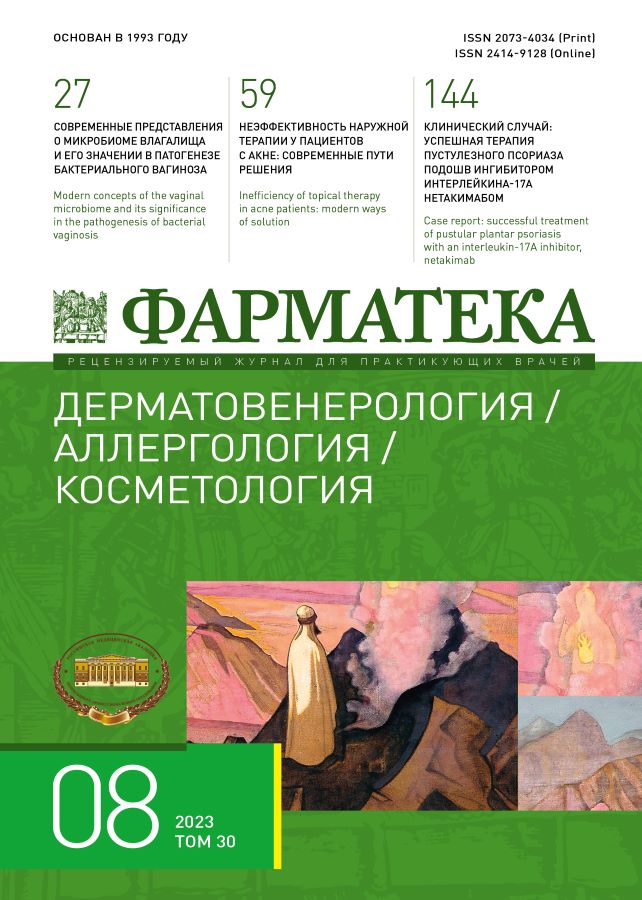Dyshidrotic palmoplantar eczema
- 作者: Yunusovа E.I.1, Yusupova L.A.1, Mavlyutova G.I.1, Garaeva Z.S.1
-
隶属关系:
- Kazan State Medical Academy – Branch Campus of RMACPE
- 期: 卷 30, 编号 8 (2023)
- 页面: 42-46
- 栏目: Clinical experience
- ##submission.datePublished##: 10.11.2023
- URL: https://journals.eco-vector.com/2073-4034/article/view/623087
- DOI: https://doi.org/10.18565/pharmateca.2023.8.42-46
- ID: 623087
如何引用文章
详细
The article presents data on dyshidrotic palmjplantar eczema, characterized by blisters with a histological picture of spongiotic vesicles. As a rule, the exact prevalence of dyshidrotic palmoplantar eczema is difficult to establish due to the lack of specific biomarkers. The frequency of occurrence ranges from 0.05–10.6% among the adult population and up to 20% of all cases of dermatoses of the hands and feet. Interestingly, the prevalence of this disease may decrease with age. Dyshidrotic palmjplantar eczema often makes it difficult to identify the etiological factor and conduct subsequent treatment. The disabling and recurrent nature of dyshidrotic palmoplantar eczema affects the quality of life of patients. Adverse trigger factors, including fungal infections, hyperhidrosis, nickel allergy, and reactivation of contact allergies, can contribute to the onset and exacerbation of dyshidrotic palmoplantar eczema. Currently, the incidence of dyshidrotic palmoplantar eczema against the background of atopic diseases, erythroderma and endogenous reactions to allergens has increased, indicating the importance of contact dermatitis, in which cosmetics and hygiene products play a predominant role compared to metals. Dyshidrotic palmoplantar eczema remains a chronic skin disease that can progress to a severe clinical picture where vesicles enlarge and form deep, painful fissures that eventually render the patient incapable of work and daily life. Today, various therapeutic approaches are available, but the disease is often resistant to traditional therapies. The article discusses causal relationships, etiological factors of development and histopathological manifestations of the disease. Various variants of the clinical picture are revealed; diagnostics, treatment and prevention of dyshidrotic palmoplantar eczema are presented.
全文:
作者简介
E. Yunusovа
Kazan State Medical Academy – Branch Campus of RMACPE
Email: yuluizadoc@hotmail.com
ORCID iD: 0000-0002-4550-9578
SPIN 代码: 7590-6182
俄罗斯联邦, Kazan
Luiza Yusupova
Kazan State Medical Academy – Branch Campus of RMACPE
编辑信件的主要联系方式.
Email: yuluizadoc@hotmail.com
ORCID iD: 0000-0001-8937-2158
SPIN 代码: 5743-6872
Dr. Sci. (Med.), Professor, Head of the Department of Dermatovenereology and Cosmetology
俄罗斯联邦, KazanG. Mavlyutova
Kazan State Medical Academy – Branch Campus of RMACPE
Email: yuluizadoc@hotmail.com
ORCID iD: 0000-0002-4652-8869
SPIN 代码: 3427-8924
俄罗斯联邦, Kazan
Z. Garaeva
Kazan State Medical Academy – Branch Campus of RMACPE
Email: yuluizadoc@hotmail.com
ORCID iD: 0000-0001-9096-0563
SPIN 代码: 3156-8170
俄罗斯联邦, Kazan
参考
- Вольф К., Голдсмит Л.А., Кац С.И. Дерматология Фицпатрика в клинической практике. 2012. 870 с. [Wolf K., Goldsmith L.A., Katz S.I. Fitzpatrick’s dermatology in clinical practice. 2012. 870 р. (In Russ.)].
- Родионов А.Н. Дерматовенерология. Руководство для врачей. 2012. 1200 с. [Rodionov A.N. Dermatovenereology. Guide for doctors. 2012. 1200 р. (In Russ.)].
- Юсупова Л.А. Современный взгляд на проблему старения кожи. Лечащий врач. 2017;6:75. [Yusupova L.A. Modern view on the problem of skin aging. Lechashchii vrach. 2017;6:75. (In Russ.)].
- Adams D.R. Acute eczema, hand-foot (dyshidrotic eczema). Liter. Rev. 2013. Р. 1–3
- Юсупова Л.А. Современное состояние проблемы эксфолиативного дерматита. Лечащий врач. 2019;11:6–8. [Yusupova L.A. The current state of the problem of exfoliative dermatitis. Lechashchii vrach. 2019;11:6–8. (In Russ.)].
- Purnamasari L. Dermatitis Dishidrotik. CDK. 2018;45(2):98–101. doi: 10.55175/cdk.v45i2.169.
- Юсупова Л.А., Мингазетдинова Н.И. Сов-ременное состояние проблемы сухой кожи. Лечащий врач. 2014;5:41. [Yusupova L.A., Mingazetdinova N.I. The current state of the problem of dry skin. Lechashchii vrach. 2014;5:41. (In Russ.)].
- Ikeda К. Pompholyx after IV immunoglobulin therapy for neurologic disease. Neurol. 2000;54(9):1879. doi: 10.1212/wnl.54.9.1879.
- Man I. Photoinduced pompholyx: a report of 5 cases. J Am Acad Dermatol. 2004;50(1):55–60. doi: 10.1016/s0190-9622(03)00891-0.
- Юсупова Л.А., Хафизьянова Р.Х. Результаты лечения больных атопическим дерматитом с использованием димефосфона. Терапевтический архив. 2005;77(12):70–4. [Yusupova L.A., Hafizyanova R.H. Results of treatment of patients with atopic dermatitis using dimephosphone. Terapevticheskii arkhiv. 2005;77(12):70–4. (In Russ.)].
- Politiek K., Lohman L., Pas H.H., et al. Eksema hiperkeratotik dari tangan: Eksim atau tidak? Contact. Dermatit. 2020;83(3):196–205. doi: 10.1111/cod.13572.
- Юсупова Л.А. Диагностика и комплексная терапия атопического дерматита у больных с психическими расстройствами. Вестник последипломного медицинского образования. 2003;2:11–4 [Yusupova L.A. Diagnosis and complex therapy of atopic dermatitis in patients with mental disorders. Vestnik poslediplomnogo meditsinskogo obrazovaniya. 2003;2:11–4. (In Russ.)].
- Ruff S.M.D., Engebretsen K.A., Zachariae C., et al. The relationship between atopic dermatitis and eczema of the hands: a systematic review and meta-analysis. Br J Dermatol. 2018;178(4):879–88. doi: 10.1111/bjd.16147.
- Юсупова, Л.А. Распространенность эпидермофитий у больных, имеющих психические расстройства. Успехи медицинской микологии. 2003;2:201. [Yusupova L.A. The prevalence of epidermophytosis in patients with mental disorders. Uspekhi meditsinskoi mikologii. 2003;2:201. (In Russ.)].
- Yamamoto T. Clinical characteristics of Japanese patients with palmoplantar pustulosis. Clin. Drug Res. 2019;39:241–52. doi: 10.1007/s40261-018-00745-6.
- Юсупова Л.А. Распространенность хронических дерматозов у больных с психическими расстройствами. Вестник последипломного медицинского образования. 2003;3–4:46–8. [Yusupova L.A. Prevalence of chronic dermatoses in patients with mental disorders. Vestnik poslediplomnogo meditsinskogo obrazovaniya. 2003;3–4:46–8. (In Russ.)].
- Jordens Q., De Maiziere H., De Crem C., et al. Sacred manifestations associated with infection. Pediatr Dermatol. 2021;38(6):1475–87. doi: 10.1111/pde.14831ю
- Уджуху В.Ю., Короткий Н.Г., Абдуллаева А.Э., Кубылинский А.А. Особенности наружной терапии у больных экземой. Фарматека. 2003;9:44–8. [Ujuhu V.Yu., Korotkiy N.G., Abdullayeva A.E., Kubylinsky A.A. Features of external therapy in patients with eczema. Farmаteka. 2003;9:44–8. (In Russ.)].
补充文件







